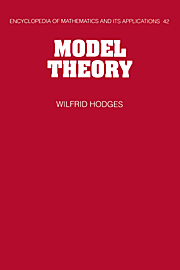Book contents
- Frontmatter
- Contents
- Introduction
- Note on notation
- 1 Naming of parts
- 2 Classifying structures
- 3 Structures that look alike
- 4 Automorphisms
- 5 Interpretations
- 6 The first-order case: compactness
- 7 The countable case
- 8 The existential case
- 9 The Horn case: products
- 10 Saturation
- 11 Combinatorics
- 12 Expansions and categoricity
- Appendix: Examples
- References
- Index to symbols
- Index
Introduction
Published online by Cambridge University Press: 08 October 2009
- Frontmatter
- Contents
- Introduction
- Note on notation
- 1 Naming of parts
- 2 Classifying structures
- 3 Structures that look alike
- 4 Automorphisms
- 5 Interpretations
- 6 The first-order case: compactness
- 7 The countable case
- 8 The existential case
- 9 The Horn case: products
- 10 Saturation
- 11 Combinatorics
- 12 Expansions and categoricity
- Appendix: Examples
- References
- Index to symbols
- Index
Summary
Should I begin by defining ‘model theory’? This might be unsafe – do the readers get their money back if the definition doesn't match the contents? But here is an attempt at a definition: Model theory is the study of the construction and classification of structures within specified classes of structures.
A ‘specified class of structures’ is any class of structures that a mathematician might choose to name. For example it might be the class of abelian groups, or of Banach algebras, or sets with groups which act on them primitively. Thirty or forty years ago the founding fathers of model theory were particularly interested in classes specified by some set of axioms in first-order predicate logic – this would include the abelian groups but not the Banach algebras or the primitive groups. Today we have more catholic tastes, though many of our techniques work best on the first-order axiomatisable classes. One result of this broadening is that model theorists are usually much less interested than they used to be in the syntactical niceties of formal languages – if you want to know about formal languages today, you should go first to a computer scientist.
‘Construction’ means building structures, or sometimes families of structures, which have some feature that interests us.
- Type
- Chapter
- Information
- Model Theory , pp. ix - xiPublisher: Cambridge University PressPrint publication year: 1993



